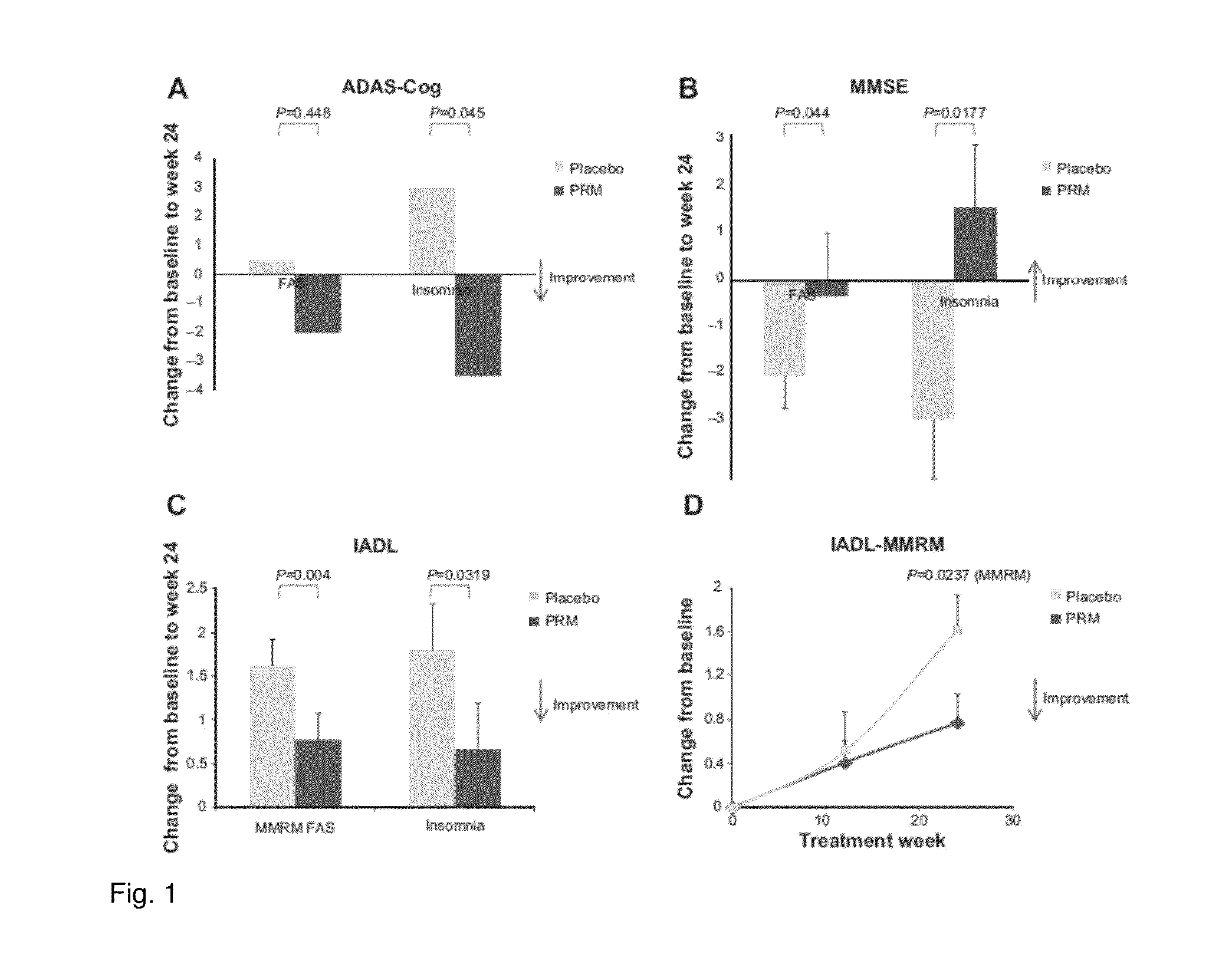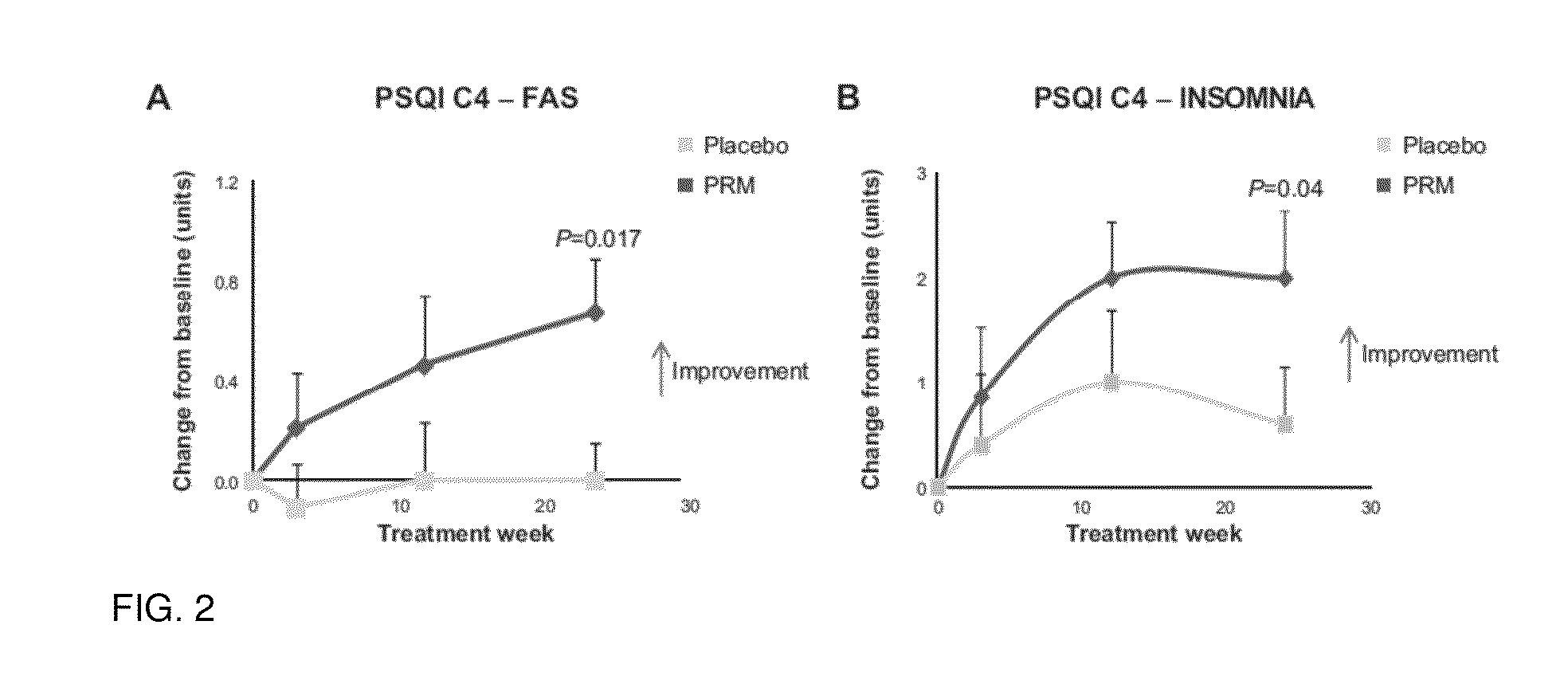Method and composition for enhancing cognition in alzheimer's patients
a technology for alzheimer's patients and compositions, applied in the field of pharmaceutically active combinations, can solve the problems of relapsing condition that can be difficult to treat, sleep problems, and high cortisol levels, and achieve the effect of improving cognitive function and memory
- Summary
- Abstract
- Description
- Claims
- Application Information
AI Technical Summary
Benefits of technology
Problems solved by technology
Method used
Image
Examples
example 1
[0082]The effect of a controlled release formulation of melatonin on subjectively assessed sleep quality in 17 elderly insomnia patients (aged 66.9 (SD 5.4) years) were studied in a randomized, double-blind, crossover study. Basal excretion of the main melatonin metabolite 6-sulfatoxymentonin in urine over the nocturnal period (8 p.m.-8 a.m.) was measured and the subjects were treated for 1 week with placebo to establish baseline characteristics followed by a two-period crossover design (4 weeks on either melatonin controlled release 2 mg or placebo) separated by a washout period (1 week). On the last week of the baseline and treatment periods patients were asked to assess the quality of their sleep the previous night by ticking a 140 mm visual analog scale. The distance (in mm) of the patient mark from the left hand side of the scale was measured and a higher number indicated better sleep. The difference from placebo values in the patient evaluation of restful sleep was calculated ...
example 2
[0083]The effects of a controlled release formulation of melatonin on subjectively assessed sleep quality were studied in a mixed age insomnia patients population (aged 20-80 years). The subjects were treated for 1 week with placebo to establish baseline characteristics and then for 3 weeks with 1 mg per night of controlled release melatonin or placebo. On the last three days of the baseline and treatment periods patients were asked to assess the quality of their sleep the previous night using the Leeds Sleep Evaluation Questionnaire (Parrott, A. C. and I. Hindmarch (1980). “The Leeds sleep evaluation questionnaire in psychopharmacological investigations—a review.” Psychopharmacology (Berl) 71(2): 173-9) which comprises two 100 mm visual analog scales relating to sleep quality. The distance of the patient mark from the right hand side in mm was measured and the mean answer of the two questions was averaged across the 3 consecutive nights. A responder was defined as a patient showing...
example 3
[0084]The effect of a controlled release formulation of melatonin on psychomotor performance (total reaction time, TRT, and Mean reaction time, MRT) in 40 elderly insomnia patients (aged 60.8 (SD 0.8) years) were studied. The subjects were treated for 2 weeks with placebo (baseline) and 3 weeks with 2 mg per night of controlled release melatonin. On the last two days of treatment psychomotor tests were taken by all patients to assess daytime vigilance. The improvement in Psychomotor skills in patients treated with melatonin were significantly higher in the smokers (−38.95 msec on TRT and −36.07 on MRT) compared to non-smokers group (−5.21 and 0.62 msec, p=0.05 and p=0.03, respectively).
PUM
| Property | Measurement | Unit |
|---|---|---|
| Mean reaction time | aaaaa | aaaaa |
| area | aaaaa | aaaaa |
| time | aaaaa | aaaaa |
Abstract
Description
Claims
Application Information
 Login to View More
Login to View More - R&D
- Intellectual Property
- Life Sciences
- Materials
- Tech Scout
- Unparalleled Data Quality
- Higher Quality Content
- 60% Fewer Hallucinations
Browse by: Latest US Patents, China's latest patents, Technical Efficacy Thesaurus, Application Domain, Technology Topic, Popular Technical Reports.
© 2025 PatSnap. All rights reserved.Legal|Privacy policy|Modern Slavery Act Transparency Statement|Sitemap|About US| Contact US: help@patsnap.com



